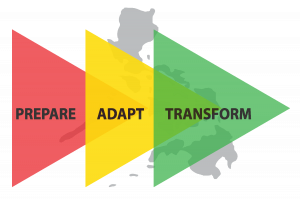By Amb. Roberto R. Romulo
Of the 95 fatalities so far reported as a direct result of Typhoon Ompong that slammed into Northern Luzon last week, 16 people perished from the wind and flooding that it brought. The majority of those who perished – 79 so far – was the result of a landslide that buried a small settlement of miners and their families in Itogon. The relatively low number of casualties in other parts of Luzon can be attributed to the pro-active and pre-emptive actions by the government – at all levels – in evacuating residents at risk to safer areas. Conversely, the high number of casualties in Itogon was as a result of the absence of such preparedness by government.
Cause of deaths
It is not the landslides’ fault that people died. This seems rather harsh to say but not if you consider that disasters happen when hazards intersect with people resulting in the loss of lives or and destruction of property. A landslide in a remote, unpopulated area would be characterized as a natural phenomenon. But the people in Itogon were working and living in harm’s way. They lived on the slopes where they were engaged in small scale mining as their only or main source of livelihood. Limestone is known to be both porous and powdery. One needs to ask why communities were permitted to live beneath them. The same question might be asked of people living in Naga, Cebu and Itogon, Benguet.
What was missing
Overall risk governance was missing. Why were the people left exposed and vulnerable? Apparently there were many warnings from both DILG and the private sector of the need to vacate the landslide prone area. Instead of heeding these, small scale mining was permitted implicitly or explicitly by the mayor in dangerous slopes. The lure of gold that benefit the miners and the local government led the latter to overlook the risks that the local chief executive should have known and who should have designed and implemented the appropriate policies and interventions – including designating no-build danger zones.
Need
Hazard science is needed at Ground Zero. Watching attempts to locate those buried in Itogon and Benguet brought back memories of the rockslide that buried the town of Guinsaugon, Southern Leyte in February 2006 claiming the lives of over 1,300 people. Had there been base maps that showed where people and buildings actually were before it happened, a more effective search and rescue plan could have been undertaken.
Availability?
Disaster forensics is needed to inform future action on prevention on resilience. Thanks to advances in scientific research in the DOST and in academe, there is a considerable amount of good hazard science already available. But is anyone in charge of analyzing the hazard data against the exposure and vulnerability of communities and sectors, such as agriculture? Why are people in harm’s way, in the first place? Why won’t people move during a preemptive evacuation? Risk analyses and new metrics are essential to addressing the complexity of evolving risks and achieving a multi-stakeholder, whole-of society collaboration for resilience.
New metrics needed to guide a multi-stakeholder resilience roadmap. The clear directions coming from the top that I praised in part one of this column were largely undone by poor operational know-how and commitment on the ground. It is with this realization that the National Resilience Council is working on improving the risk governance capabilities of LGUs. Local chief executives and their teams will use a resilience scorecard and undergo a three-year program on science-based leadership and governance which will enable them to develop innovative public-private initiatives to reduce risk in their jurisdiction.
Aside from poverty, it can be said that those killed in disasters are victims of organizational failure particularly at the local government level to address past, current and future risks. They should be held accountable for such misgovernance and not pass the buck.
“Towards a digital future”
On Nov. 7, the Carlos P. Romulo Foundation for Peace and Development will host this conference in cooperation with PLDT and others. I have always expressed concern that the Philippines, once the leader in ASEAN information technology, is now the laggard. On the relatively new challenge of the 4th Industrial Revolution, we urgently need to focus on this from a government and private sector perspective. In a modest way, that is the raison d’etre for the conference.
Two key invitees are the Secretary of Science and Technology (DOST) and the Secretary of Information Communication Technology (DICT). In today’s STAR, the column of DR. Sicat discussed the challenge of the 4th Industrial Revolution. He described the DOST presentation at a recent PIDS conference as “lame”. He also expressed concern that DICT was focused solely on the plans for a third telco.
On the subject of DOST, I believe that Secretary de la Pena will acquit himself satisfactorily at the conference. During my last meeting with him, I was very impressed with his programs which is a manifestation of his competence.
On the subject of DICT, I sympathize with Secretary Rio because he is under pressure from the Palace on the issue of a third telco even as I express my belief that there is an urgent need for an e-government portal where all government services can be transacted. I also cite the provision in the law for the creation of a CIO Council. Perhaps the absence of such a council is the reason for no focus on e-government. I hope the Secretary will accept my invitation. The conference is the appropriate venue for discussion of these two topics.
SOURCE:
Romulo, R. (2018, September 28). Lessons from Typhoon Ompong, Filipino Worldview. Retrieved from https://www.philstar.com/business/2018/09/28/1855247/lessons-typhoon-ompong
![]()


